
Zincke reaction
Encyclopedia
The Zincke reaction is an organic reaction
in which a pyridine
is transformed into a pyridinium salt by reaction with 2,4-dinitro-chlorobenzene and a primary amine, named after Theodor Zincke
.
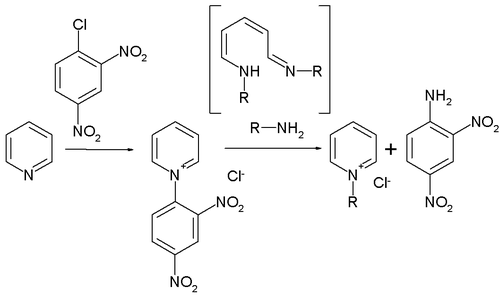 The Zincke reaction should not be confused with the Zincke-Suhl reaction
The Zincke reaction should not be confused with the Zincke-Suhl reaction
or the Zincke nitration. Furthermore, the Zincke reaction has nothing to do with the chemical element zinc
.
.
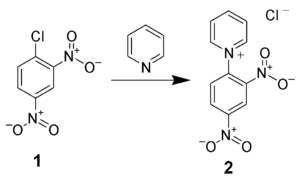 Upon heating a primary amine with the N-2,4-dinitrophenyl-pyridinium salt (2), the addition of the amine leads to the opening of the pyridinium ring. A second addition of amine leads to the displacement of 2,4-dinitroaniline (5) and formation of the König salt (6a and 6b). The trans-cis-trans isomer of the König salt (6a) can react by either sigmatropic rearrangement
Upon heating a primary amine with the N-2,4-dinitrophenyl-pyridinium salt (2), the addition of the amine leads to the opening of the pyridinium ring. A second addition of amine leads to the displacement of 2,4-dinitroaniline (5) and formation of the König salt (6a and 6b). The trans-cis-trans isomer of the König salt (6a) can react by either sigmatropic rearrangement
or nucleophilic addition
of a zwitterion
ic intermediate to give cyclized intermediate (7). This has been suggested to be the rate-determining step
. After proton transfer and amine elimination
, the desired pyridinium ion (9) is formed.
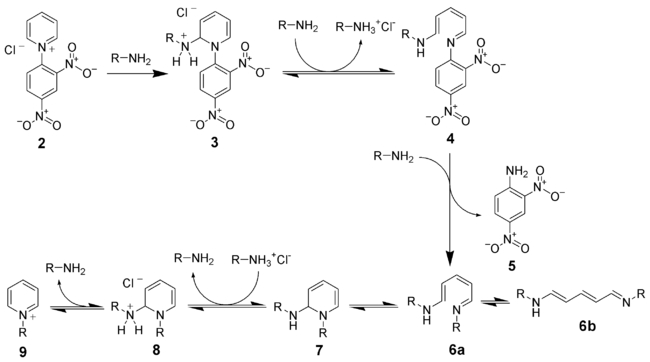 This mechanism can be referred to as an instance of the ANRORC mechanism
This mechanism can be referred to as an instance of the ANRORC mechanism
: nucleophilic addition (AN), ring opening and ring closing.
application, the amine is covalently attached to Wang resin.
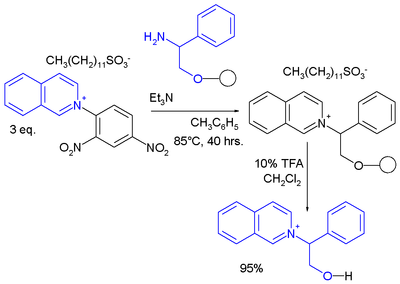 Another example is the synthesis of a chiral
Another example is the synthesis of a chiral
isoquinolinium
salt.
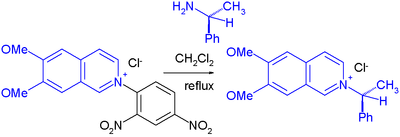
s in which the pyridine ring is ring-opened with the terminal iminium
group hydrolyzed to an aldehyde
:
 This variation has been applied in the synthesis of novel indole
This variation has been applied in the synthesis of novel indole
s :
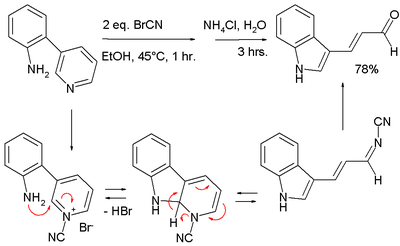 with cyanogen bromide
with cyanogen bromide
mediated pyridine activation.
(structure 1) from an N-aryl pyridinium chloride and an amine
, an aniline
in the case of the Japanese group (depicted below) and an aliphatic amine (anticipating surfactant
properties) in the case of the American group.
In a letter to Angewandte Chemie
, the German chemist Manfred Christl pointed out not only that the alleged new chemistry was in fact 100 year old Zincke chemistry but also that the proposed structure for the reaction product was not the 12 membered ring but the 6 membered pyridinium salt (structure 2). Initially both groups conceded that they had ignored existing literature on Zincke but held on to the annulene structure based on their electrospray ionization
(ESI) results which according to them clearly showed dimer. In his letter Christl remarked that in ESI measurements association of molecules is a common phenomenon. In addition, he noted similarities in melting point
and NMR spectroscopy
.
As of December 2007 the Japanese group retracted its paper in Organic Letters
due to uncertainties regarding what products are formed in the reaction described and the US group added a correction to theirs in the Angewandte Chemie stating they wish(ed) to alter the proposed structure of (the) annulene. The issue did receive some media coverage:
Organic reaction
Organic reactions are chemical reactions involving organic compounds. The basic organic chemistry reaction types are addition reactions, elimination reactions, substitution reactions, pericyclic reactions, rearrangement reactions, photochemical reactions and redox reactions. In organic synthesis,...
in which a pyridine
Pyridine
Pyridine is a basic heterocyclic organic compound with the chemical formula C5H5N. It is structurally related to benzene, with one C-H group replaced by a nitrogen atom...
is transformed into a pyridinium salt by reaction with 2,4-dinitro-chlorobenzene and a primary amine, named after Theodor Zincke
Theodor Zincke
Theodor Zincke was a German chemist and the academic adviser of Otto Hahn.-Life:Theodor Zincke was born in Uelzen on 19 May 1843. He became a pharmacist and graduated in Göttingen with his Staatsexamen. He began studying chemistry with Friedrich Wöhler and received his Ph.D in 1869...
.

Zincke-Suhl reaction
The Zincke-Suhl reaction is a special case of a Friedel-Crafts alkylation and was first described by Theodor Zincke and Suhl.The classic example of this reaction is the conversion of p-cresol to a cyclohexadienone . Melvin Newman, a scientist from the U.S...
or the Zincke nitration. Furthermore, the Zincke reaction has nothing to do with the chemical element zinc
Zinc
Zinc , or spelter , is a metallic chemical element; it has the symbol Zn and atomic number 30. It is the first element in group 12 of the periodic table. Zinc is, in some respects, chemically similar to magnesium, because its ion is of similar size and its only common oxidation state is +2...
.
Reaction mechanism
The first reaction is the formation of the N-2,4-dinitrophenyl-pyridinium salt (2). This salt is typically isolated and purified by recrystallizationRecrystallization (chemistry)
-Chemistry:In chemistry, recrystallization is a procedure for purifying compounds. The most typical situation is that a desired "compound A" is contaminated by a small amount of "impurity B". There are various methods of purification that may be attempted , which includes recrystallization...
.

Sigmatropic reaction
A sigmatropic reaction in organic chemistry is a pericyclic reaction wherein the net result is one σ-bond is changed to another σ-bond in an uncatalyzed intramolecular process. The name sigmatropic is the result of a compounding of the long-established sigma designation from single carbon-carbon...
or nucleophilic addition
Nucleophilic addition
In organic chemistry, a nucleophilic addition reaction is an addition reaction where in a chemical compound a π bond is removed by the creation of two new covalent bonds by the addition of a nucleophile....
of a zwitterion
Zwitterion
In chemistry, a zwitterion is a neutral molecule with a positive and a negative electrical charge at different locations within that molecule. Zwitterions are sometimes also called inner salts.-Examples:...
ic intermediate to give cyclized intermediate (7). This has been suggested to be the rate-determining step
Rate-determining step
The rate-determining step is a chemistry term for the slowest step in a chemical reaction. The rate-determining step is often compared to the neck of a funnel; the rate at which water flows through the funnel is determined by the width of the neck, not by the speed at which water is poured in. In...
. After proton transfer and amine elimination
Elimination reaction
An elimination reaction is a type of organic reaction in which two substituents are removed from a molecule in either a one or two-step mechanism...
, the desired pyridinium ion (9) is formed.

ANRORC mechanism
The ANRORC mechanism in organic chemistry describes a special type of substitution reaction. ANRORC stands for Addition of the Nucleophile, Ring Opening, and Ring Closure in nucleophilic attack on ring systems and it helps to explain product formation and distribution in some nucleophilic...
: nucleophilic addition (AN), ring opening and ring closing.
Applications
In one solid-phase synthesisSolid-phase synthesis
In chemistry, solid-phase synthesis is a method in which molecules are bound on a bead and synthesized step-by-step in a reactant solution; compared with normal synthesis in a liquid state, it is easier to remove excess reactant or byproduct from the product. In this method, building blocks are...
application, the amine is covalently attached to Wang resin.

Chirality (chemistry)
A chiral molecule is a type of molecule that lacks an internal plane of symmetry and thus has a non-superimposable mirror image. The feature that is most often the cause of chirality in molecules is the presence of an asymmetric carbon atom....
isoquinolinium
Isoquinoline
Isoquinoline is a heterocyclic aromatic organic compound. It is a structural isomer of quinoline. Isoquinoline and quinoline are benzopyridines, which are composed of a benzene ring fused to a pyridine ring. In a broader sense, the term isoquinoline is used to make reference to isoquinoline...
salt.

Zincke aldehydes
With secondary amines and not primary amines the Zincke reaction takes on a different shape forming so-called Zincke aldehydeZincke aldehyde
Zincke aldehydes, or 5-aminopenta-2,4-dienals, are the product of the reaction of a pyridinium salt with two equivalents of any secondary amine, followed by basic hydrolysis...
s in which the pyridine ring is ring-opened with the terminal iminium
Iminium
An iminium salt or cation in organic chemistry has the general structure [R1R2C=NR3R4]+ and is as such a protonated or substituted imine. It is an intermediate in many organic reactions such as the Beckmann rearrangement, Vilsmeier-Haack reaction, Stephen reaction or the Duff reaction...
group hydrolyzed to an aldehyde
Aldehyde
An aldehyde is an organic compound containing a formyl group. This functional group, with the structure R-CHO, consists of a carbonyl center bonded to hydrogen and an R group....
:

Indole
Indole is an aromatic heterocyclic organic compound. It has a bicyclic structure, consisting of a six-membered benzene ring fused to a five-membered nitrogen-containing pyrrole ring. Indole is a popular component of fragrances and the precursor to many pharmaceuticals. Compounds that contain an...
s :

Cyanogen bromide
Cyanogen bromide is a pseudohalogen compound with the formula CNBr. It is a colorless solid that is widely used to modify biopolymers, fragment proteins and peptides, and synthesize other compounds.-Synthesis, basic properties, and structure:...
mediated pyridine activation.
2007 rediscovery
In 2006 and again in 2007 the Zincke reaction was rediscovered by a research group from Japan and a group from the USA. Both groups claimed the synthesis of a 12 membered diazaannuleneAnnulene
Annulenes are completely conjugated monocyclic hydrocarbons. They have the general formula CnHn or CnHn+1...
(structure 1) from an N-aryl pyridinium chloride and an amine
Amine
Amines are organic compounds and functional groups that contain a basic nitrogen atom with a lone pair. Amines are derivatives of ammonia, wherein one or more hydrogen atoms have been replaced by a substituent such as an alkyl or aryl group. Important amines include amino acids, biogenic amines,...
, an aniline
Aniline
Aniline, phenylamine or aminobenzene is an organic compound with the formula C6H5NH2. Consisting of a phenyl group attached to an amino group, aniline is the prototypical aromatic amine. Being a precursor to many industrial chemicals, its main use is in the manufacture of precursors to polyurethane...
in the case of the Japanese group (depicted below) and an aliphatic amine (anticipating surfactant
Surfactant
Surfactants are compounds that lower the surface tension of a liquid, the interfacial tension between two liquids, or that between a liquid and a solid...
properties) in the case of the American group.
In a letter to Angewandte Chemie
Angewandte Chemie
Angewandte Chemie is a weekly peer-reviewed scientific journal that covers all aspects of chemistry. Its impact factor was 12.730 in 2010, the highest value for a chemistry-specific journal that publishes original research...
, the German chemist Manfred Christl pointed out not only that the alleged new chemistry was in fact 100 year old Zincke chemistry but also that the proposed structure for the reaction product was not the 12 membered ring but the 6 membered pyridinium salt (structure 2). Initially both groups conceded that they had ignored existing literature on Zincke but held on to the annulene structure based on their electrospray ionization
Electrospray ionization
Electrospray ionization is a technique used in mass spectrometry to produce ions. It is especially useful in producing ions from macromolecules because it overcomes the propensity of these molecules to fragment when ionized...
(ESI) results which according to them clearly showed dimer. In his letter Christl remarked that in ESI measurements association of molecules is a common phenomenon. In addition, he noted similarities in melting point
Melting point
The melting point of a solid is the temperature at which it changes state from solid to liquid. At the melting point the solid and liquid phase exist in equilibrium. The melting point of a substance depends on pressure and is usually specified at standard atmospheric pressure...
and NMR spectroscopy
NMR spectroscopy
Nuclear magnetic resonance spectroscopy, most commonly known as NMR spectroscopy, is a research technique that exploits the magnetic properties of certain atomic nuclei to determine physical and chemical properties of atoms or the molecules in which they are contained...
.
As of December 2007 the Japanese group retracted its paper in Organic Letters
Organic Letters
Organic Letters , is a peer-reviewed scientific journal, published since 1999 by the American Chemical Society....
due to uncertainties regarding what products are formed in the reaction described and the US group added a correction to theirs in the Angewandte Chemie stating they wish(ed) to alter the proposed structure of (the) annulene. The issue did receive some media coverage:


